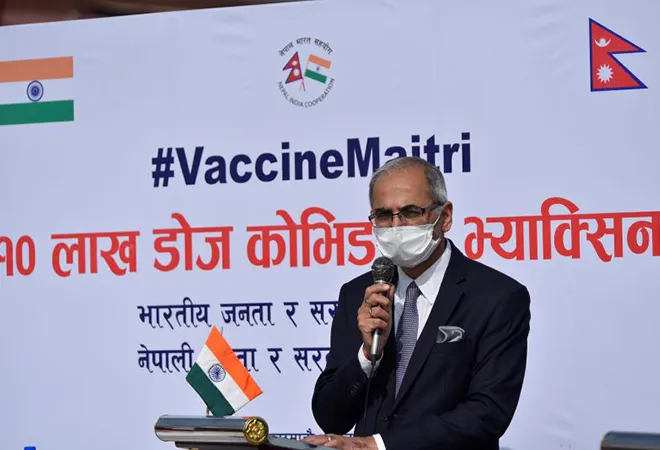
Since time immemorial, people-to-people relations between Nepal and India have remained unique mainly because it is based on the twin pillars of an open border system and people-to-people contacts of kinship. Because of the open border system, the citizens of these countries cross over the Nepal-India border for
livelihood opportunities apart from marriages; familial ties; cultural, social, and economic security; and even political affairs. Also, the over 80 percent Hindu population in both countries integrate the people.
Given his Neighbourhood First Policy and the importance that Nepal holds in India’s strategic consideration, Indian Prime Minister, Narendra Modi, visited Nepal four times during his tenure of six years, which reflects the priority that the Indian government accords to its relations with Kathmandu.
However, all is not well between Nepal and India, at least at the government-to-government level. At times, certain differences crop up in the relations between the two countries. Last year in 2020, ties between the two soured after both India and Nepal — one after the other — published maps in which they included Kalapani, Lipulekh, and Limpiyadhura region in their side of the territory.
But in its bid to reset the country’s relations with India, the Nepalese Prime Minister, K.P. Sharma Oli directly spoke to PM Modi on the phone to greet him on the occasion of India’s Independence Day on 15 August 2020. Subsequently, three senior-most dignitaries of India, including the RAW Chief, Samanta Goel; Army Chief, M.M. Narvane; and Foreign Secretary, Harsh Vardhan Shringla; apart from the
Foreign Cell Chairman of the Bharatiya Janata Party (BJP), Vijay Chauthaiwale; visited Nepal between October and December last year, to mend the differences between the two countries. Such visits re-opened the communication channels that had remained stalled for over a year.
All is not well between Nepal and India, at least at the government-to-government level.
Consequently, the air services between Nepal and India were resumed. Importantly, the
Nepalese and Indian authorities reviewed an all-important gamut of bilateral issues in the Sixth Meeting of the Nepal-India Joint Commission (JC) in New Delhi on 15 January 2021. Issues discussed in this forum ranged from COVID-19 vaccine(s) to boundary and border management, connectivity, economic cooperation, trade, transit, power, water resources, culture, and education. Set up in 1987, the JC, which is now co-chaired by the Nepalese Minister for Foreign Affairs, Pradeep Kumar Gyawali, and his Indian counterpart, S. Jaishankar, happens to be the highest-level mechanism between the two countries to discuss bilateral issues. The two sides expressed satisfaction over the progress made in implementing different bilateral projects.
Immediately after the JC meeting, India provided
one million doses of Oxford-AstraZeneca’s Covishield vaccine to Nepal as grant assistance to generate goodwill among the Nepalese people, which was manufactured by Serum Institute of India (SII), the largest producer of vaccines in the world. As per the commitment made, India also provided this vaccine to other neighbours apart from Nepal. The vaccines that Nepal received from India are being administered to the needy people in all the seven provinces of the country as per the distribution plan set by the federal government.
In the first phase, the vaccines are being given to
health workers, security personnel, and frontline workers, which will be followed by those in the second phase who are senior citizens with chronic diseases. The Oli government, which has been struggling for its survival for quite some time due to the protests made by the rival faction of the ruling Nepal Communist Party and some of the opposition parties over the issue of dissolution of the Nepalese parliament, has appreciated India for this support.
For quite some time, the trust deficit between Nepal and India largely affected the implementation of various Indian-aided projects in Nepal.
There is a feeling that India’s vaccine diplomacy gave a jolt to China, which was expanding its footprint all over South Asia, including in Nepal. As per some, China had assured Nepal of provision of the Sinopharm vaccine, but the Nepalese government has not yet been given permission for its import. The Nepalese Drug Administration is collecting the necessary information before it can make any decision concerning the approval of this vaccine.
For quite some time, the trust deficit between Nepal and India largely affected the implementation of various Indian-aided projects in Nepal. At times, some of the Indian investment projects had been attacked. Indian notes of higher denominations such as INR 500 or INR 2,000 are still banned in Nepal, which causes difficulties for people while they travel to each other’s country.
Besides, Indians are expected to possess work permit to work in Nepal. Vehicles with Indian number plates find it difficult to operate in Nepal. Nepal has not yet opened its border with India that has been closed for nearly 10 months on the pretext of COVID-19. The growing rivalry between India and China to increase their influence in Nepal is also a problem in creating a healthy environment for investment in the country.
Nepal has not yet opened its border with India that has been closed for nearly 10 months on the pretext of COVID-19.
Even though Nepal-India relations are largely governed by people-to-people relations, the importance of government-to-government relations can no longer be underestimated. Considering India’s economic and strategic importance for Nepal, Kathmandu needs to enhance cultural ties and people-to-people contact with India. It also needs to create a congenial environment in the country to enable India to complete its projects in Nepal on time. Nepal could further attract Indian investment in the hydropower sector in the Himalayan river system. Also, Indian companies in Nepal should be given adequate protection in the country.
Since Nepal’s dependence on India is more than India’s dependence on Nepal, it is all the more necessary to balance such relations. To increase India’s dependence on Nepal, it is necessary to place the increase in trade and economic activities at the forefront. Interdependence between Nepal and India is the secret to reset the relations between the neighbours. Towards this end, the two countries could also build an international corridor along the 1,753 kilometre Nepal-India border region to facilitate greater movement of commercial vehicles between the two countries. The focus should be given to more air, road, train, and waterways connectivity, apart from playing an active role in several important multilateral forums such as BBIN (Bangladesh, Bhutan, India and Nepal), BIMSTEC, NAM, and SAARC to serve their common interests.
The views expressed above belong to the author(s). ORF research and analyses now available on Telegram! Click here to access our curated content — blogs, longforms and interviews.



 Since time immemorial, people-to-people relations between Nepal and India have remained unique mainly because it is based on the twin pillars of an open border system and people-to-people contacts of kinship. Because of the open border system, the citizens of these countries cross over the Nepal-India border for
Since time immemorial, people-to-people relations between Nepal and India have remained unique mainly because it is based on the twin pillars of an open border system and people-to-people contacts of kinship. Because of the open border system, the citizens of these countries cross over the Nepal-India border for  PREV
PREV


